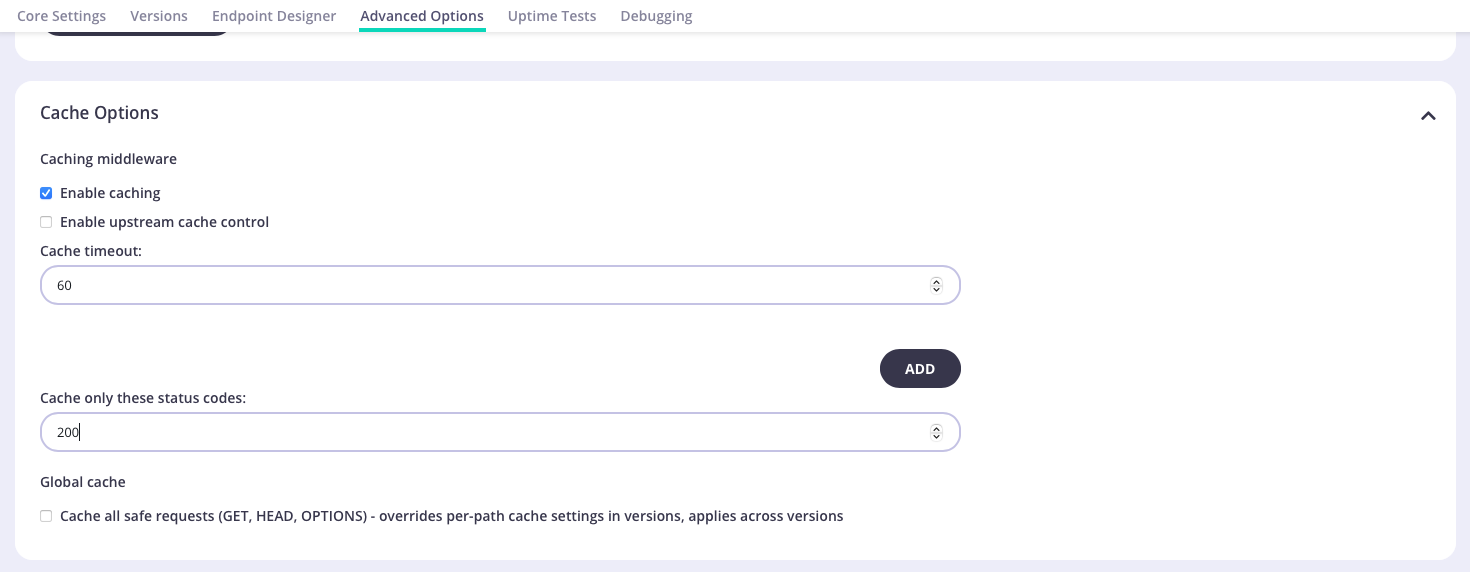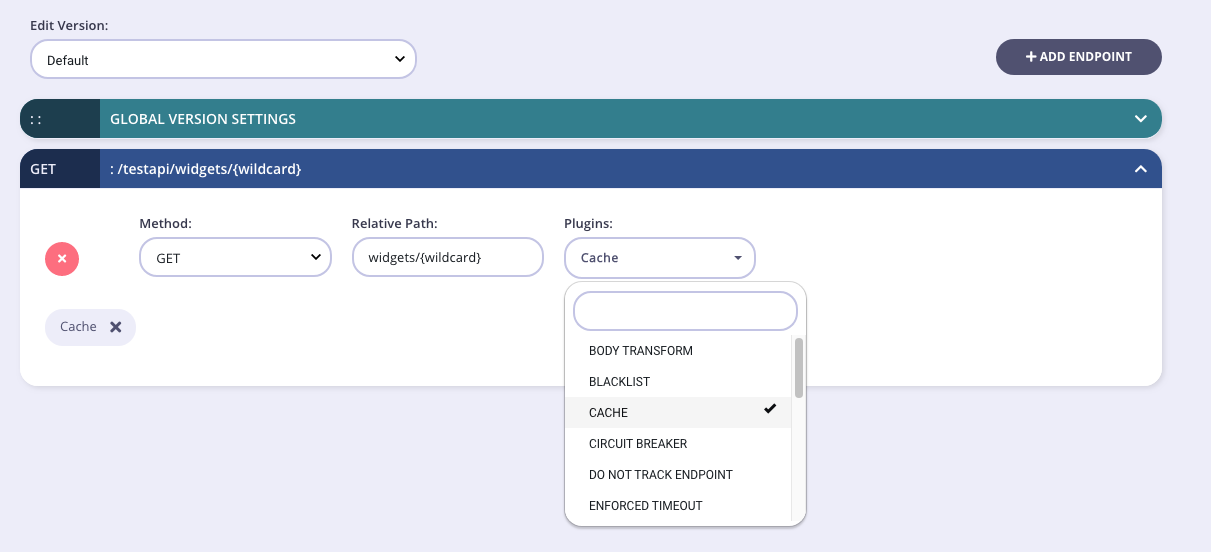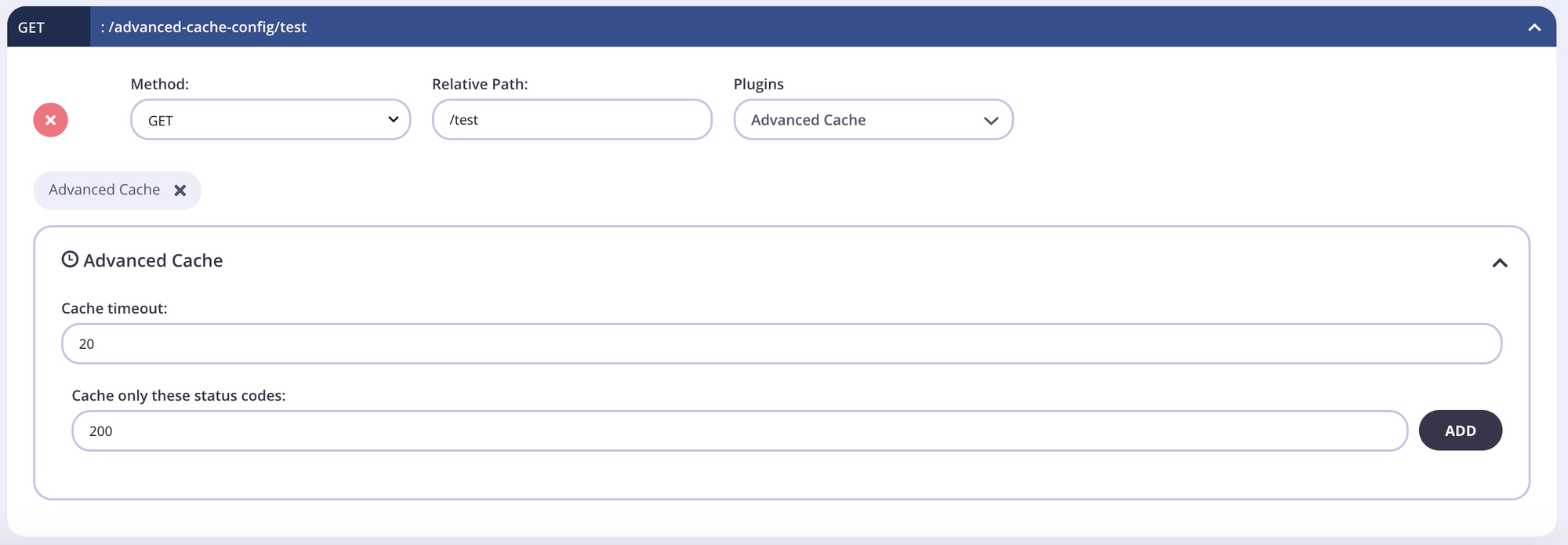Advanced Caching
Last updated: 6 minutes read.
On this page we describe how to configure Tyk’s API response cache per endpoint within an API. This gives granular control over which paths are cached and allows you to vary cache configuration across API versions. For details on the API level (Global) cache you should refer to the global-cache configuration page.
When you use the API-level cache, Tyk will maintain a cache entry for each combination of request method, request path (endpoint) and API key (if authentication is enabled) for an API. The Endpoint Caching middleware gives you granular control over which paths are cached and allows you to vary cache configuration across API versions.
By default Tyk maintains a cache entry for each combination of request method, request path (endpoint) and API key (if authentication is enabled) for an API.
You can optionally choose to cache more selectively so that only a subset of endpoints within the API will be cached.
Configuring the endpoint-level cache
Within the API Definition, the per-endpoint cache controls are grouped within the extended_paths section.
There are two elements within extended_paths that are used to configure this granular cache:
cache: Used to cache all safe requests to specific endpointsadvance_cache_config: Used for more granular caching and advanced features
Caching by endpoint (all safe requests)
If caching is enabled then, by default, Tyk will create separate cache entries for every endpoint (path) of your API. This may be unnecessary for your particular API, so Tyk provides a facility to cache only specific endpoint(s).
To configure endpoint-selective caching, you must:
- ensure that
enable_cacheis set totrue - ensure that
cache_all_safe_requestsis set tofalse - add a list of the endpoint(s) to be cached in the
cachelist within theextended_pathssection of the API definition
Note
You must disable cache_all_safe_requests in the basic (API-wide) caching configuration for per-endpoint caching to work, otherwise requests to all endpoints within the API will be cached.
For example, if you want to cache only the /widget, /badger and /fish endpoints of your API, with a 60 second TTL you would set the following in the API definition:
"cache_options": {
"enable_cache": true,
"cache_timeout": 60,
"cache_all_safe_requests": false
},
...
"version_data": {
...
"versions": {
...
[versionName]:{
...
"use_extended_paths": true,
"extended_paths": {
"cache": [
"widget",
"badger",
"fish"
]
}
}
}
}
Advanced caching by endpoint
For ultimate control over what Tyk caches, you should use the advanced configuration options for the per-endpoint cache. You can separately configure, for each HTTP method for an endpoint:
- an individual TTL (timeout) define
- a list of HTTP response codes that should be cached
- a pattern match to cache only requests containing specific data (this is explained here)
To use this most granular functionality of Tyk’s cache, you must not enable safe request caching at either the API-level (cache_all_safe_requests) or endpoint-level (cache[]).
The fields within advance_cache_config provide Tyk with the precise details of how you wish to cache calls to that endpoint (combination of HTTP method and path).
method- HTTP method to be cached (typicallyGET)path: Must match an endpoint/path provided in thecachelist.timeout: Given in seconds (if not provided, the timeout configured incache_timeoutwill be used)cache_response_codes: HTTP responses codes to be cached (for example200)cache_key_regex: Pattern match for selective caching by body value
For example, if you want to cache the /widget, /badger and /fish endpoints of your API with different timeouts (TTL) and for different response codes you might set the following in the API definition:
"cache_options": {
"enable_cache": true,
"cache_all_safe_requests": false
},
...
"version_data": {
...
"versions": {
...
[versionName]:{
...
"use_extended_paths": true,
"extended_paths": {
"advance_cache_config": [
{
"method":"GET"
"path":"widget"
"timeout":30
"cache_response_codes": [200]
},
{
"method":"GET"
"path":"badger"
"timeout":20
"cache_response_codes": [200, 201]
},
{
"method":"GET"
"path":"fish"
"timeout":60
"cache_response_codes": [200]
}
]
}
}
}
}
Selective caching by body value
You can configure Tyk’s cache to create a separate cache entry for each response where the request matches a specific combination of method, path and body content.
Body value caching is configured within the extended_paths.advance_cache_config section in your API definition.
The string you provide in cache_key_regex will be compared with the request body and, if there’s a match anywhere in the body, the response will be cached.
For example, to create a cache entry for each response to a POST request to your API’s addBooks endpoint that contains the string my_match_pattern in the body of the request, you would set:
"cache_options": {
"enable_cache": true,
"cache_all_safe_requests": false
},
...
"version_data": {
...
"versions": {
...
[versionName]:{
...
"use_extended_paths": true,
"extended_paths": {
"advance_cache_config": [
{
"method":"POST",
"path":"addBooks",
"cache_key_regex": "my_match_pattern",
"timeout": 60
}
]
}
}
}
}
Configuring endpoint caching in the Dashboard
Caching all safe requests by endpoint in the Dashboard
In the Tyk Dashboard you can configure caching per endpoint for your APIs by assigning the cache middleware to the desired combinations of endpoint and HTTP method.
Step 1: configure the API level caching options from the Advanced Options tab in the Endpoint Designer
- Enable caching to enable the cache middleware
- Cache timeout to configure the timeout (in seconds) for cached requests Cache only these status codes is where you list which HTTP status codes should be cached. Remember to click Add after entering a code to add it to the list.
- Cache all safe requests ensure that this is not selected, otherwise the responses from all endpoints for the API will be cached.

Step 2: go into the Endpoint Designer tab and for the path(s) you want to cache, select the Cache plugin from the drop-down list.

Advanced caching by endpoint in the Dashboard
Similarly, you can configure caching per endpoint for your APIs by assigning the advanced_cache middleware to the desired combinations of endpoint and HTTP method.
Step 1: configure the API level caching options from the Advanced Options tab in the Endpoint Designer as follows
- Enable caching to enable the cache middleware
- Cache timeout to configure the default timeout (in seconds) for any endpoints for which you don’t want to configure individual timeouts
- Cache only these status codes leave this blank
- Cache all safe requests ensure that this is not selected, otherwise the responses from all endpoints for the API will be cached.
Step 2: go into the Endpoint Designer tab and for the path(s) you want to cache, select the Advanced Cache plugin from the drop-down list.
Step 3: Configure the Advanced Cache (timeout and HTTP response codes) for each combination of path and method as required. If you don’t need to set a specific timeout for an endpoint you can leave this blank and Tyk will use the cache timeout configured previously.

Note
Body value match caching is not currently exposed in the Dashboard UI, so it must be enabled though either the raw API editor or the Dashboard API.